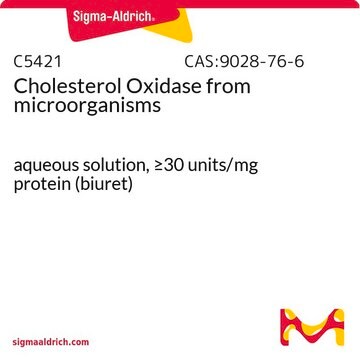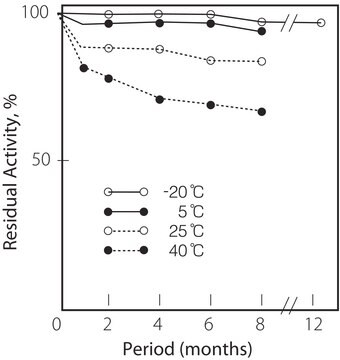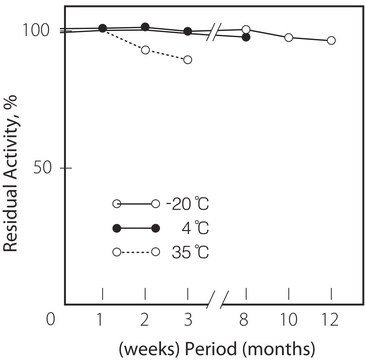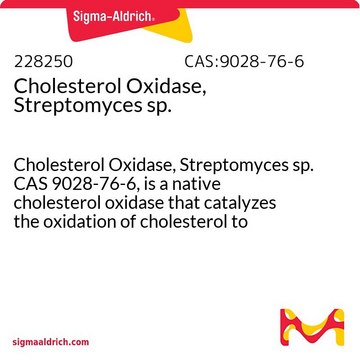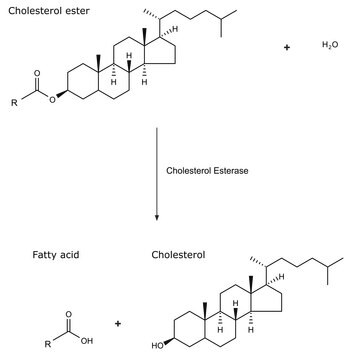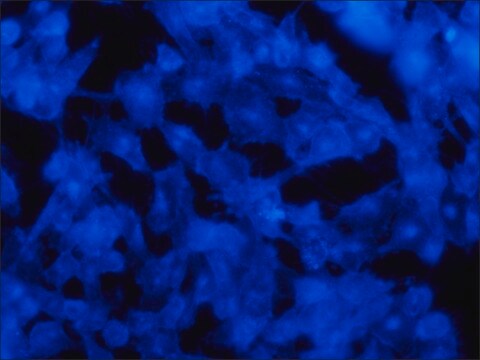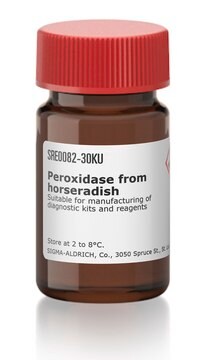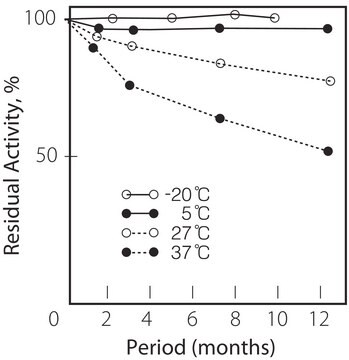C8868
Cholesterol Oxidase from microorganisms
lyophilized powder, ≥50 units/mg protein, recombinant, expressed in E. coli
Synonym(s):
Cholesterol: oxygen oxidoreductase
Sign Into View Organizational & Contract Pricing
All Photos(1)
About This Item
Recommended Products
recombinant
expressed in E. coli
form
lyophilized powder
specific activity
≥50 units/mg protein
mol wt
64 kDa
composition
Protein, ≥15% biuret
storage temp.
−20°C
Application
Cholesterol oxidase has been used in a study to demonstrate that microheterogeneity in hydrophobic-hydrophilic block copolymer systems can be exploited for immobilizing enzymes and to carry out enzymatic reactions. Cholesterol oxidase has also been used in a study that concluded that amphipaths that activate cholesterol might be useful in treating NPC disease.
Cholesterol oxidase is used to determine serum cholesterol. The enzyme also finds application in the microanalysis of steroids in food samples and in distinguishing 3-ketosteroids from 3β-hydroxysteroids. Transgenic plants expressing cholesterol oxidase are being investigated in the fight against the cotton boll weevil. CHOD has also been used as a molecular probe to elucidate cellular membrane structures.
Biochem/physiol Actions
Cholesterol oxidase (CHOD) is a monomeric flavoprotein containing FAD that catalyzes the first step in cholesterol catabolism. This bifunctional enzyme oxidizes cholesterol to cholest-5-en-3-one in an FAD-requiring step, which is then isomerized to cholest-4-en-3-one with the release of H2O2.
Physical properties
Type II cholesterol oxidase containing FAD cofactor covalently linked to the enzyme.
Unit Definition
One unit will convert 1.0 μmole of cholesterol to 4-cholesten-3-one per min at pH 7.5 at 25 °C. Note: 4-cholesten-3-one may undergo isomerization.
Physical form
Supplied as a lyophilzed powder containing sucrose
signalword
Danger
hcodes
pcodes
Hazard Classifications
Resp. Sens. 1
Storage Class
11 - Combustible Solids
wgk_germany
WGK 3
flash_point_f
Not applicable
flash_point_c
Not applicable
ppe
Eyeshields, Gloves, type N95 (US)
Choose from one of the most recent versions:
Already Own This Product?
Find documentation for the products that you have recently purchased in the Document Library.
Customers Also Viewed
Block copolymer microdomains: a novel medium for enzymatic reactions
Gupte, A., et al.
Biotechnology Progress, 7, 348-354 (2012)
Meihe Zhang et al.
Biosensors & bioelectronics, 32(1), 288-292 (2011-12-31)
A novel cholesterol biosensor was prepared based on gold nanoparticles-catalyzed luminol electrogenerated chemiluminescence (ECL). Firstly, l-cysteine-reduced graphene oxide composites were modified on the surface of a glassy carbon electrode. Then, gold nanoparticles (AuNPs) were self-assembled on it. Subsequently, cholesterol oxidase
Laura Caldinelli et al.
The Journal of biological chemistry, 280(24), 22572-22581 (2005-04-09)
Cholesterol oxidase from Brevibacterium sterolicum is a monomeric flavoenzyme catalyzing the oxidation and isomerization of cholesterol to cholest-4-en-3-one. This protein is a class II cholesterol oxidases, with the FAD cofactor covalently linked to the enzyme through the His(69) residue. In
Effect of cholesterol concentration on organization of viral and vesicle membranes. Probed by accessibility to cholesterol oxidase.
R Pal et al.
The Journal of biological chemistry, 255(12), 5802-5806 (1980-06-25)
D R Corbin et al.
Plant physiology, 126(3), 1116-1128 (2001-07-18)
Cholesterol oxidase represents a novel type of insecticidal protein with potent activity against the cotton boll weevil (Anthonomus grandis grandis Boheman). We transformed tobacco (Nicotiana tabacum) plants with the cholesterol oxidase choM gene and expressed cytosolic and chloroplast-targeted versions of
Our team of scientists has experience in all areas of research including Life Science, Material Science, Chemical Synthesis, Chromatography, Analytical and many others.
Contact Technical Service